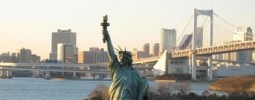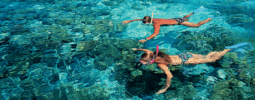Hanoi is the capital of Vietnam. The city is situated on the bank of the Red River which is in the North of the country. While Hanoi is not the largest city in the country (which is Ho Chi Minh) it has had a rich history. It has been inhabited since 3000 B.C and has served the government seat for nearly 1000 years. Hanoi has a population of 3.4 million people.
Once arrived at Noi Bai Airport it takes about an hour to get into town, this ride offers you glimpses of modern Vietnamese life; farmers in their fields, great rivers, modern highways that occasionally become bumpy roads. Somehow the sun setting seems perfect as it always disappears into the cornfields horizon. Once into the city you are surrounded by roadside artisans, shops and taverns, commuters on bicycles, cyclos and motorbikes. Modern buildings appear from nowhere and look so out of place, you start to wonder if they dropped from the sky.
To leave the tourist attractions and city life behind, be warning this is for adventurous only! rent a Russian Minsk and follow the road towards the hills. This route offers one of the world’s most stunning scenery which stops in hill tribe villages, including a motorcyclist’s dream of long mountain roads. Most of these roads are unpaved, alternately dusty and dangerously muddy. At full throttle this track can be completed within a week but most adventurous travelers take at least two weeks. There’s a possibility to do the tour by jeep also.
Travelers to Hanoi need a valid passport and visa. US passport holders must have a valid passport and a visa is required. Travel in Vietnam is generally safe and violent crime is uncommon. Pick-pocketing is rife, and drive-by purse snatching is a common trick. The summer months are between May and September, though rain can be expected.
Tokyo officially known as Tokyo Metropolis is the capital of Japan since 1868. The Japanese government and the Imperial Palace, as well the home of the Japanese Imperial Family are situated in the city. Tokyo along with Paris, New York and London is considered to be one of the four world cities. The city has a population of over 12 million people.
Tokyo grew from a modest fishing village within 400 years to a giant modern society. It’s split up in several districts containing fabulous shopping and sightseeing, fine restaurants and bars, spacious shopping malls & markets, interesting museums & history events. With its 1250 square miles to explore Tokyo has a variety in geography, it not spans just the city but also the rugged mountains in the west and the subtropical islands in the south.
Once the cost of living in Tokyo was astronomical. This has changed due deflation and market pressures, nowadays its comparable to other large international cities. Travelers from cities as New York, London, Paris and Toronto will not be surprised by the prices. If you plan a trip to Tokyo you should budget similar amount of money then when traveling to other large cities in Europe or North America.
Travelers to Tokyo need a valid passport and visa. American Citizens will receive a 90 days visa upon arrival. The city is generally safe for tourists, general travel rules apply so look after your belongings. The best period to visit Tokyo is in the summer months June till August.
The mountainous town of Sapa is located in the northwest Hoang Lien Son mountains of Vietnam, known as “the Tonkinese Alps”. Sapa is situated in the Lao Cai Province along the border with China. The town was built in 1922 and it used to be a hill station. Sapa is rapidly growing into a hot tourist spot where tourists can enjoy a world of mysterious minority cultures and beautiful landscapes. Sapa has a population of 7 thousand people.
The surroundings of the picturesque town of Sapa includes rice terraces, lush vegetation and Fanispan, the highest peak in Vietnam. Simply follow the steps up to the Sapa Radio Tower to take a view over the magnificent valley. You will often find the mountains shrouded in mist that rolls back and forth along the peaks. You can also visit the tourist attraction Ham Rong Resort with various viewpoints, gardens, dance performances and restaurants. Remember that you will have to pay entrance here. The town of Sapa is small enough to reach everything within by foot.
In and around Sapa there live many ethnic minorities and hill-tribe people, such as the Hmong, the Dao and the Red Zao tribe. They come wander in to town to buy, sell and trade. Trying to get a conversation started can be very rewarding, but don’t try this in the town itself. Many of the ethnic people will only smell a potential sale. If you like adventure, sign-up or a trekking trip through the mountains with an overnight stay at one of the villages nearby. These villages can also be reached via jeep, motorcycle and van.
Travelers to Sapa need a valid passport and visa. Make sure you respect the wishes of the ethnic groups living in Sapa and the surrounding valleys. It is also important to bring your foreign currency notes as new and crispy as possible. Although it is obliged to turn over your passport to your hotel, guesthouse or hostel, a photocopy of this document or your visa will do the trick.
The small town Sisophon is located in the northwest of Cambodia. It is the capital city of Banteay Meanchy. The town is officially named Serei Saophoan, which is generally transliterated as Sisophon. The name Serei Saophoan is Khmer for “beautiful lady”. The area used to be inside Thailand before the French gave it back to Cambodia. Sisophon is strategically situated at the intersection of National Highway 5 en National Highway 6.
Sisophon makes a good first stop when traveling from Poipet in the west. It is also a good place to start exploring some sights around. It is about fourty minutes to get to the Khmer temple of Banteay Chmar, to the north of the town. You can also visit the Angkorian temple of Banteay Top. More to the northeast there is a special bird sanctuary, called Ang Trapeng Thmor Reserve.
Sisophon is connected to many other cities in Cambodia through the National Highways. Traveling from the town to other cities is easy, but be aware of the state of the roads. Highway 69 for instance to Banteay Chmar is impassable during raining seasons. Battabamg to the south, Poipet to the west and Siem Reap to the east are more accessible by driving on Highway 5 or Highway 6.
Travelers to Sisophon and Cambodia require a valid passport and visa. American citizens will receive a visa upon arrival valid for 30 days in exchange for $20.00 US. There’s also an exit fee of $25.00 US when leaving the country.
The Thai cuisine has among the largest variety of food in the world, as well its famous for being spicy. The key to secret lies within the mixture of spices as garlic, chili, lemon grass, basil, coconut milk and ginger. The believe that every Thai dish is spicy, is false. There’s a wide selection of choices such as sour, sweet, salty or bitter.
Singapore is the capital city of the smallest country (city-state) in Southeast Asia: the Republic of Singapore. It lies close to the southern extremity of the Eurasian tectonic plate and the northeast extension of the Sumatra-Java oceanic trench. It has a population of 4.8 million people.
Since it’s independence Singapore has become one of the world’s most prosperous countries and sports the world’s busiest port. To picture Singapore’s skyline combine in your mind the many skyscrapers and subways of a modern city with a mix of Chinese, Indian and Malay influences and climate, including tasty Asian foods, fabulous shopping, vibrant nightlife and busy markets.
Singapore counts many nationals with different backgrounds. Therefore the capital is split up in different areas, each area is unique to it’s own. Fortune tellers, calligraphers and temple worshippers are part of everyday life in the crowded streets of Chinatown. In Little India, you can buy the best freshly ground spices, sari materials or picture of your favorite Hindu god. In the tiny shops of Arab Streets, the cry of the imam can be heard from the local Sultan Mosque.
Traveling to Sentosa Island is one of the highlights of a Singapore trip. The island was originally meant for the British to defend the city from the Japanese. Since it has been transformed into a beach resort with amusement park, golf club and a soon to be opened casino.
Travelers to Singapore need a valid passport and visa. American Citizens will receive a 90 days visa upon arrival. The best time to travel to Singapore is from June to August, travelers should be aware it might be still rainy and humid and should pack accordingly. Travelers with laptop can consider themselves lucky, the whole city has free WIFI.
The people of Thailand celebrate life with the philosophy of ‘Sanuk’, which means ‘enjoying pleasure’. Celebrations are seldom ‘ceremonious’ and serious but always frivolous and colorful. Yearly celebrations, religious celebrations and celebrations within certain seasons are an essential part of the daily Thai culture. Thai people feast every month, as much as possible, according to a 13th century motto: ‘Who wants to be happy, should do it’.
The city of Manila or simply Manila is the capital and second most populous city (after Quezon City) of the Philippines. The city is located on the eastern shore of the Manila Bay just west of the National Capital Region in the western side of Luzon. Manila has a population of 1.6 million people.
Manila is a still developing world city with common problems such as choking smog, traffic and poverty. However, this should not dissuade anyone from traveling to Manila. It’s a diverse and excotic place for the adventurous tourist that likes to discover on its own. Also low budget travelers will be satisfied with Manila as travel expenses are cheap compared to the experience & knowledge you will gain during the trip.
Manila’s rich culture, exclusive nightlife and shopping center’s shall impress you, seeing is believing! As the city is still developing itself there are a few downers travelers should be aware of. Decent European/American food in restaurants are rare to find and there’s a lack of working ATM machines (ATM machines that do work, will only allow you to take out maximum of 10 thousand pesos about $200 US a time).
Travelers to Manila must have a valid passport and visa. American Citizens receive a 30 day visa upon arrival. You don’t have to worry about getting lost in Manila as the English language is widely spoken by Philippinos. The best period to visit Manila are in the summer months from January till April when there’s the least rain.








